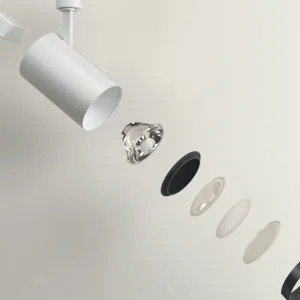There are noticeably more LED exterior fittings around and, importantly, they are becoming more viable. As the products on these pages demonstrate, the latest offerings vary from the strictly decorative to the seriously technical – and the distinction needs to be made when specifying. The big sales pitch – as always with LEDs – is energy efficiency. However, efficacy will depend on the quality of the LEDs and the fitting.
ILO
AEC (Kingfisher Lighting)
The ILO comes with four LED arrangements (36, 54, 72 and 90 Osram Golden Dragon LEDs) and lamp output ranges from 3235lm (48W) to 8088lm (120W). Colour temperature is a cool 6000K. Each LED is housed in an individual mirrored optic, which increases the emitting surface of each LED but reduces the glare. The positioning of the LED arrays gives the exact distribution required, with 4m-8m mounting heights. Optics and gear are sealed (IP66) for the life of the lantern, which Italian high-spec manufacturer AEC says is 90,000 hours, providing the lantern operates at 80 per cent maintained illumination with an ambient temperature of 25 deg C.
www.kingfisherlighting.com
Lavinia
iGuzzini
Designed byMassimiliano and Doriana Fuksas, the Lavinia has a direct road optic featuring 39 or 59 1Wcool white LEDs (5500K). Driven at 350m/A, temperature is based at 60 deg C with an ambient temperature of 25deg C. The system has a thermal management system that reduces the output if the ambient and junction temperatures exceed the set figures. Output is 70lm/W. The fitting also has vertical adjustment with a graduated scale that goes from +15deg C to -5deg C. There is a range of single and double mounting options, according to the application.
www.iguzzini.com
CitySpirit
Philips Lighting
One of the features of the CitySpirit is its constant light output (CLO) electronic control, which ensures the light output is maintained at a constant level during the 50,000-hour service life of the lamp. It also ensures the light output is always at the required level. With a choice of warm white (3000K) or neutral white (4000K), the fitting has asymmetrical, rotationally symmetric or bidirectional lenses for street or space lighting. Philips has gone down the modular rather than sealed route, so that the LED module and the driver can easily be changed at the end of their service life, a unique feature in LED street lighting, acccording to Philips. The maximum system wattage is 30W, while the average wattage based on service life and automatic CLO is 25W. The light (1400lm) is generated by a matrix of 22 high-output LEDs, each with a meniscus lens to direct the light.
www.lighting.philips.com
This article was first published in FX Magazine.





